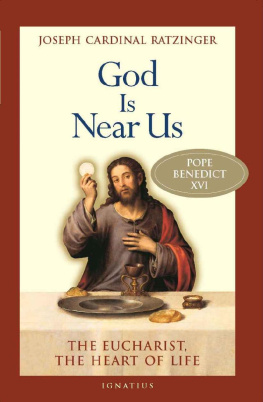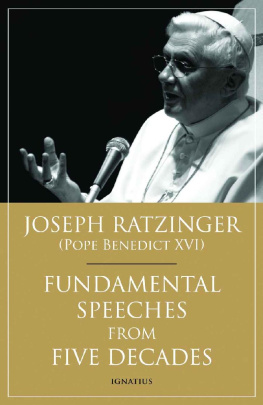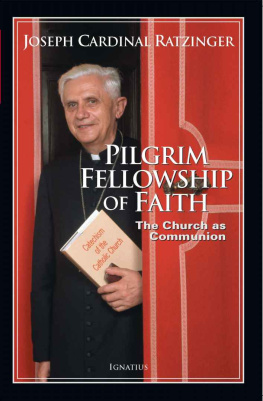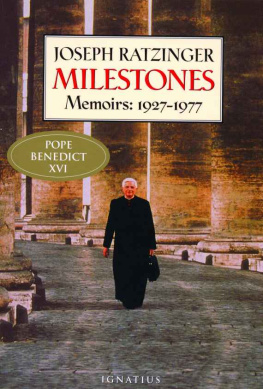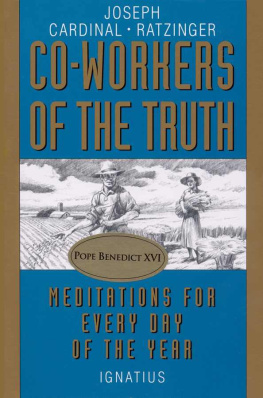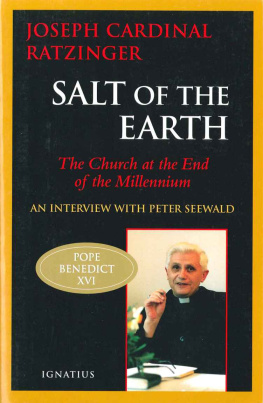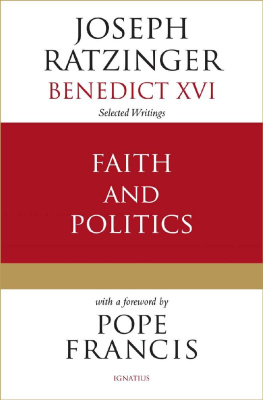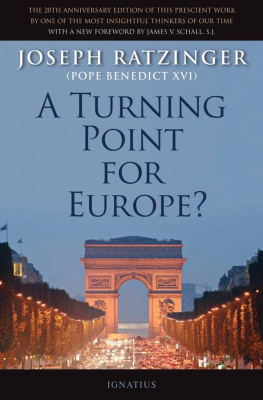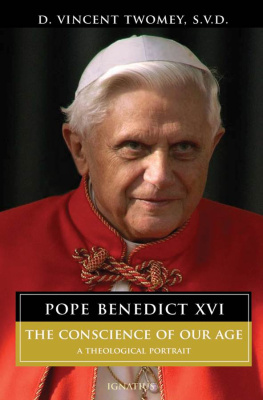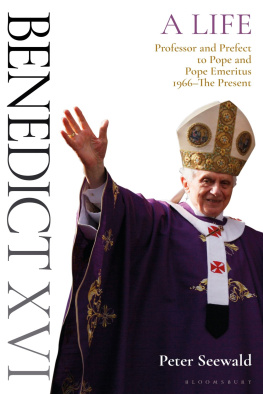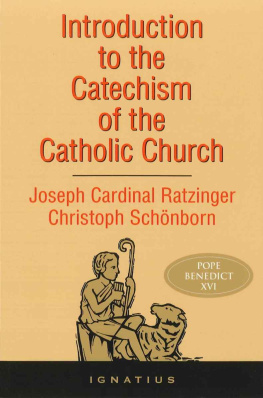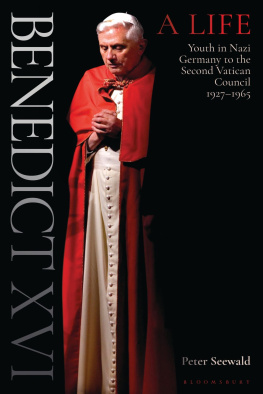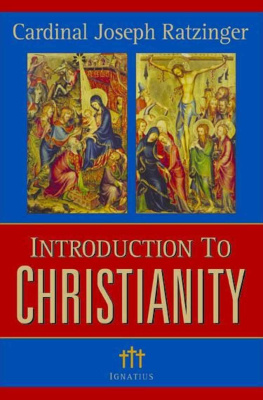GOD AND THE WORLD
JOSEPH CARDINAL RATZINGER
God and the World
Believing and Living in Our Time
A Conversation with Peter Seewald
Translated by Henry Taylor
IGNATIUS PRESS SAN FRANCISCO
Title of the German original:
Gott und die Welt: Glauben und Leben in unserer Zeit
Ein Gesprch mit Peter Seewald
2000 DeutscheVerlags-Amtalt, Stuttgart, Munich
Cover art; Creation of Adam :
Detail of Adam (Detail of the Siscme chapel ceiling)
Michaelangelo (1475-1564)
Vatican Palace, Vatican City State
Copyright Scala / Art Resource, New York
Cover design by Roxanne Mei Lum
2002 Ignatius Press, San Francisco
All rights reserved
ISBN 978-0-89870-868-4
Library of Congress Control Number 2002105231
Printed in the United States of America
Contents
3. CREATION
In the Beginning Was the Word
The Crown of Creation
So-Called Evil
Heaven and Hell
The Tree of Life
4. ORDER IN CREATION
The Fundamental Evidence of the Universe
5. THE TWO TESTAMENTS
The Old Covenant
The Book of Books
6. THE LAW
The Four Laws
The Ten Commandments
7. LOVE
The Meaning of Life
How Do We Learn to Love
Aspects of Love
Part II: JESUS CHRIST
JesusAn Invention?
8. REVELATION
Prophets and Heralds
Did God Correct Himself?
9. THE LIGHT
The Most Important Moment in History
Light of the World
II. What Did Christ Bring to Earth?
Good News
10. THE WAY
Gospels and Gospel Writers
The Way, the Truth, and the Life
Who Was Jesus Really?
The Multiplication of Loaves
Jesus and Women
The Meeting
The Wilderness
Power and Possessions
11. THE TRUTH
Son of God
The Trinity
Our Father
The Father-Son Principle
12. LIFE
The Life of Man
The Jesus Principle
True and False Cares Judging
The Two Ways
The False Prophets
13. THE MOTHER OP GOD
Ave Maria
Dogmas
The Miracles
Mercy
The Rosary
14. THE CROSS
INRIThe Passion of the Lord
The Resurrection
Part III: THE CHURCH
15. THE SPIRIT
How It All Started
The Essential Nature of the Church
The Heart of the Church
The Task of the Church
God and the Church
16. SPIRITUAL GIFTS
The Primitive Church
Paul
Mission
The Pope
The Network of the Church
17. THE SACRAMENTS
The Design for Life
Enlightenment
Maturity
The Most Sacred Action at the Most Sacred Place
The Liturgy
Guilt and Reconciliation
Marriage
Priests
Dying
18. THE FUTURE
National Church or Minority Church?
John Paul II
The Universal Church in the Future
Christian Unity
New Dangers for Faith
A Renaissance of Spirituality
Honesty
Preface
By Joseph Cardinal Ratzinger
In 1996 Peter Seewald suggested we have a conversation about the questions that people today put to the Church and that are often for them an obstacle on the path to faith. That was the origin of the book Salt of the Earth , which many welcomed with gratitude as a practical help in getting their bearings.
Because of the widespread and surprisingly positive response to this book, Mr. Seewald was prompted to suggest a second session of conversations, with a view to illuminating the inner questions of faith, an area that strikes many Christians as an impenetrable jungle in which one can hardly find ones way. Much of this, even what is important for the Christian, seems in the light of modern thought difficult to understand or to accept.
The overwhelming demands of my official work prevented this at first. What little free time I had at my disposal, I wanted to devote to writing a book about the spirit of the liturgy, which I had had in mind since the beginning of the eighties but had never been able to get down on paper. This work was finally put together in the course of three summer holidays and appeared at the beginning of this year [2000]. So at last I had time free for the second conversation with Seewald, for which he had suggested we meet in the richly symbolic abbey of Monte Cassino, motherhouse of the Benedictine order. There, strengthened by the Benedictine hospitality, we held our new interchange, which Mr. Seewald had prepared with great care. I had to rely on the inspiration of the moment.
The quiet of the monastery, the friendliness of the monks and of their abbot, the atmosphere of prayer, and the reverent celebration of the liturgy helped us a great deal; and as it turned out, we were able to celebrate with appropriate splendor the feast of Saint Scholastica, the sister of Saint Benedict. So the monks of Monte Cassino have the thanks of both authors, who experienced this venerable site as a place of inspiration.
I probably do not need to point out that each of the two writers speaks for himself and makes his own contribution Just as in Salt of the Earth , so too hereit seems to mea real dialogue developed from the differing backgrounds and ways of thinking, in which the unsparing directness of the questions and answers proved fruitful. Mr. Seewald, who tape-recorded my answers, undertook the work of transcription and any necessary editing. For my part, I read through my answers with a critical eye and although, where this seemed necessary, I have smoothed out the language or here and there made minor additions, as a whole I have left the spoken word as it stood, just as the challenge of the moment called forth. I hope this second book of dialogue will find just as friendly a reception as Salt of the Earth and that it will be of some help to many of those people who are seeking to understand the Christian faith.
Rome, August 22, 2000
Preface
By Peter Seewald
Monte Cassino, early in the year. The road snaking up to the Abbey of Saint Benedict was steep and narrow, and the higher we climbed, the colder the air became. No one said anything, not even Alfredo, the Cardinals chauffeur. I dont knowwinter was definitely past, but somehow we seemed to be worrying about the cold nights that were still to come.
When, together with Cardinal Ratzinger, I published the book-length interview Salt of the Earth , many people took the opportunity to go into a subject they had hitherto found inaccessible. The name of God was indeed more current than it had ever been, but actually people no longer knew what they were talking about when they talked about religion. I experienced this when talking with friends or among the staff of the magazine for which I worked. Within a short period of time, something like a spiritual nuclear attack had befallen large sections of society, a sort of Big Bang of the Christian culture that was our foundation. Even if people did not deny the existence of God, no one still counted on the fact that he had any power in the world, or could actually do anything.
At this period I used to visit a church every now and then. Although I had doubts and mistrusted messages of salvation, it still seemed to me beyond contradiction that the world was no accident nor the result of an explosion or something like that, as Marx and others maintained. And certainly not the creation of man, who can neither cure the common cold nor stop a dam from breaking. I became aware that behind the web of worship, prayer, and commandments there had to be some truth. We have not followed some cleverly concocted story, it says in one of the Letters of the apostles. But it would have seemed stupid to me to start making the sign of the cross or some gesture of humility such as people usually make during Mass. And whenever I looked around inside a church, I could no longer read the meaning of all that was there. The essential thing, the meaning of it all, seemed to be hidden as if behind a veil of fog.
Next page

